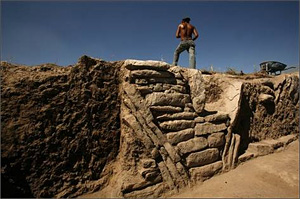 |
 |
 |
 News Around the Republic of Mexico | January 2007 News Around the Republic of Mexico | January 2007  
Archeologists Discover Ancient Olmec-Influenced City Near Mexico City
 Mark Stevenson - Associated Press Mark Stevenson - Associated Press


| | Authorities hope to excavate and preserve other pre-Hispanic sites before they are forgotten or covered over. |
A 1,500-year-old city influenced by the Olmecs - often referred to as the "mother culture" of Mesoamerica - has been discovered hundreds of kilometres away from the Olmecs' Gulf coast territory, archaeologists announced this week.

The remains of Zazacatla, 40 kilometres south of Mexico City, is providing insight into the early arrival of advanced civilizations in central Mexico, while also providing lessons about the risks to ruins posed by modern development that now cover much of the ancient city.

Archaeologist Giselle Canto said two statues and architectural details at the site indicate that the inhabitants of Zazacatla adopted Olmec styles when they changed from a simple, egalitarian society to a more complex, hierarchical one.

"When their society became stratified, the new rulers needed emblems ... to justify their rule over people who used to be their equals," Canto said of the inhabitants, who may not have been ethnically Olmec, but apparently revered the culture as the most prestigious.

Zazacatla covered about two square kilometres between 800 B.C. and 500 B.C., but much of it has been covered by housing and commercial development extending from Cuernavaca, a city popular with tourists just 12 kilometres north.

"There are 10 housing developments, a gas station, a highway and a commercial building on the site now," Canto said.

Authorities hope to excavate and preserve other pre-Hispanic sites before they are forgotten or covered over.

Since excavation of Zazacatla began last year, archaeologists have unearthed six buildings, and two sculptures of what appear to be Olmec-style priests. The sculptures appear to have headdresses portraying the jaguar, which the Olmecs revered, and other symbols of status and authority.

The Olmecs dominated areas around the Gulf coast states of Veracruz and Tabasco from 1,200 B.C. to about 400 B.C.

Some had speculated that the signs of Olmec influence found at Zazacatla and other areas far from the Gulf coast might suggest Olmec settlements, conquests or missionary sites.

But Canto said the Olmecs' most famous ceremonial centre, about 400 kilometres east, was too far for direct contact, though trade links may have existed. | 
 | |
 |



